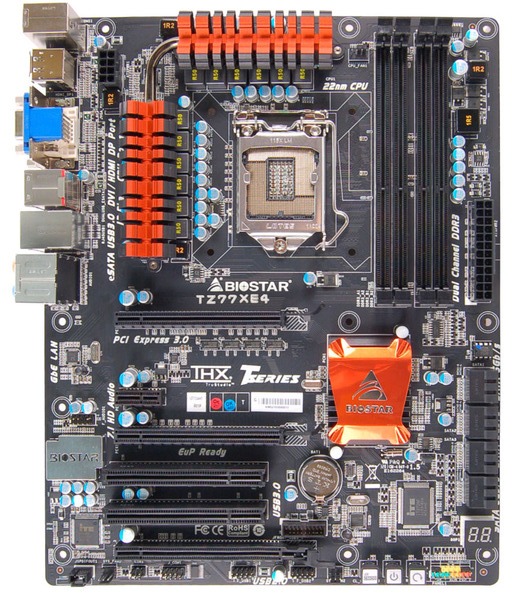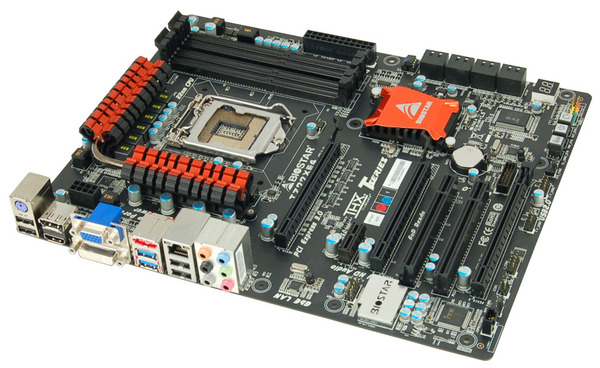Intel Z77 Panther Point Chipset and Motherboard Preview – ASRock, ASUS, Gigabyte, MSI, ECS and Biostar
by Ian Cutress on April 8, 2012 12:00 AM EST- Posted in
- Motherboards
- Intel
- Biostar
- MSI
- Gigabyte
- ASRock
- Asus
- Ivy Bridge
- ECS
- Z77
Biostar TZ77XE4—Visual Inspection
With memories of Biostar fresh in my mind from the 990FX roundup, I have another chance to tackle a motherboard from them. This one comes in at more of a premium than the other—at an MSRP of $169 it is not the cheapest board this time. However, it does seem to have learned some lessons with the PCIe layout at least, but in terms of features we are perhaps a bit lacking.
Biostar have characteristically been black and orange, and we see it here again on their top Z77 model, the TZ77XE4. Power delivery is essentially a 10+2 (CPU/iGPU) system with large brightly colored heatsinks to remove heat, both connected via a heatpipe. These heatsinks are set a little away from the Intel designated socket area, though the memory banks are right up against the boundary—with only two sticks of memory in the board there will be enough room for most of the beefiest air coolers.
In terms of fan headers, Biostar have unfortunately put much effort in here, with only three to play with—a 4-pin CPU fan header to the top right of the socket, and two 3-pin at the south end of the board. Anyone requiring headers for fans will have to resort to providing their own fan control.

Along the right hand side, apart from the 24-pin power connector, we have a series of eight SATA ports—two SATA 6 Gbps from the PCH, four SATA 3 Gbps also from the PCH, and another two SATA 6 Gbps from an ASMedia controller. These are unfortunately not color coded, meaning users will have to double check every time that the SATA cable is going into the port as intended. Below these, we have a two-digit debug display for error reporting.
The chipset heatsink sports the bright orange Biostar color, but is rather small which could lead to it being warm to the touch. On the south side of the board, we are not exactly bursting with headers—aside from the fans, we have front panel headers, a pair of USB 2.0 headers, and power/reset/clear CMOS buttons. These buttons are all similar and next to each other, so I can just see myself accidentally pressing the wrong one from time to time. It is also important to note the location of a USB 3.0 header, just above the third full-length PCIe slot. This is a rather awkward place, and cements its use primarily for rear facing adaptors (as long as there is nothing in the PCI slot beside it).

The PCIe layout is better than previous iterations, featuring an x16 (x8 in dual-GPU), x1, x8, PCI, PCI and Gen 2.0 x4. This leaves a space between GPUs, and a spare x1, PCI and x4 when dual GPUs are being used. Note we do not have a molex connector here, suggesting that Biostar are happy with the power delivery when the PCIe slots are in use.

For back panel functionality, we have a PS2 keyboard port, two USB 2.0 ports (black), DisplayPort, HDMI, D-Sub, DVI-I, eSATA, two USB 3.0 (blue), gigabit Ethernet, two more USB 2.0 (black), and audio jacks. I should stress that even though there is a DVI-I on the back panel, it does not accept analog signals by adaptor.
Board Features
| Biostar TZ77XE4 | |
| Size | ATX |
| CPU Interface | LGA-1155 |
| Chipset | Intel Z77 |
| Power Delivery | 10 + 2 + 1 + 2 (CPU/GPU/VCCIO/Memory) |
| Memory Slots |
Four DDR3 DIMM slots supporting up to 32 GB Up to Dual Channel, 1066-2600 MHz |
| Video Outputs | DisplayPort, HDMI, DVI-D, D-Sub |
| Onboard LAN | Realtek 8111E |
| Onboard Audio | Realtek ALC898 |
| Expansion Slots |
2 x PCIe x16 Gen3 (x16, x8/8) 1 x PCIe x16 Gen2 (x4) 1 x PCIe x1 Gen2 2 x PCI |
| Onboard SATA/RAID |
2 x SATA 6 Gbps (PCH), Support for RAID 0, 1, 5, 10 4 x SATA 3 Gbps (PCH), Support for RAID 0, 1, 5, 10 2 x SATA 6 Gbps (ASMedia Controller) 1 x eSATA 3 Gbps |
| USB |
4 USB 3.0 ports (2 back panel, 2 from headers) 8 USB 2.0 ports (4 back panel, 4 from headers) |
| Onboard |
4 x SATA 6 Gbps 4 x SATA 3 Gbps 1 x USB 3.0 Header 2 x USB 2.0 Header 3 x Fan Headers 1 x CIR Header 1 x SPDIF Output Header 1 x Front Panel Audio Header |
| Power Connectors |
1 x 24-pin ATX connector 1 x 8-pin 12V connector |
| Fan Headers |
1 x CPU Fan Header (4-pin) 2 x SYS Fan Header (3-pin) |
| IO Panel |
1 x PS/2 Keyboard Port 1 x eSATA 2 x USB 3.0 4 x USB 2.0 1 x DisplayPort 1 x HDMI 1 x DVI-D 1 x D-Sub 1 x Gigabit Ethernet Audio Jacks |
| Warranty Period | 3 years from date of sale |
| Product Page | Link |
Aside from the extra SATA controller, PCI slots, Power/Reset buttons and the use of all four display outputs, there's nothing much 'extra' that Biostar have put on the board which isn't already in the default chipset. This could perhaps be their downfall when it comes to conclusions after testing.










145 Comments
View All Comments
Springf - Sunday, April 8, 2012 - link
Quote: Native USB 3.0The other long awaited addition found on Panther Point is the native implementation of USB 3.0 that comes directly from the chipset. The chipset will only provide two USB 3.0 ports,
------- end quote
I think Z77 natively support 4 USB 3.0 ports
http://www.intel.com/content/dam/www/public/us/en/...
C'DaleRider - Sunday, April 8, 2012 - link
When you write sentences like this:"ASUS have a lot to live up to with its Ivy Bridge Pro board."
You do realize that you're mixing a plural verb and singular pronoun for the same damn thing...Asus in this case. First, you use a plural verb talking about Asus and then use a singular pronoun for Asus in the same sentence. You cannot do both; well, I guess you can, but you show you have no clue about English grammar and look like you dropped out of third grade.
Get a copy editor! How can anyone take this site a professional when the writing borders on illiterate?
sausagestrike - Sunday, April 8, 2012 - link
You should higher a sand removal specialist to take a look at you're twat.Arbie - Monday, April 9, 2012 - link
@C'DaleRider -You do realize that... you're the illiterate one, don't you?
"ASUS have" is perfectly legitimate English, and is in fact what you will hear in England itself. "ASUS" is a company of people and can be taken as singular or plural.
For me, the AT editors just made major points right in this set of comments by correcting another ignoramus, who was misusing "begs the question".
Now, can we get back to fan headers?
Iketh - Tuesday, April 10, 2012 - link
no, there are errors STILL all over the place in this article... it's horrid... when your site is 99% words, please make them as easy as possible to comprehend...PLEASE LEARN TO WRITE LIKE ANAND, THX!
Anand, for the love of god, pay a little more to hire a little more education (SEE WHAT I DID THAR??)
nz_nails - Monday, April 9, 2012 - link
"Biostar have unfortunately put much effort in here, with only three to play with..."Should be a "not" in there I suppose.
s1lencerman - Monday, April 9, 2012 - link
I do not understand why non express PCI slots are still on boards. The only one to see the light is MSI, and if they had a bit better performance I would switch from ASUS for my next mobo in a heartbeat. Also, why do these boards have a VGA connector (D-sub)? Intel HD graphics can only support 2 displays max, and if you have more than you should get a dedicated graphics card anyway, and probably already have. I don't see the point.Another thing, when will OEMs start putting the USB hub at the bottom of the board facing down and not away from the board. If you have multiple cards on the board then you can get really cramped really fast when you are trying to use those.
I'm sorely tempted to just wait another year or so till there is a board with these features and over 50% SATA 6G/s, but we'll see if that even comes out in that short of time.
DanNeely - Monday, April 9, 2012 - link
1) Some customers are asking for them. Customer demand was why a few boards started sporting floppy controllers again last summer. Legacy PCI demand is almost certainly much higher.2) Intel doesn't have enough PCIe lanes on the southbridge for well featured ATX boards.
2.1) This means a bridge chip of some sort.
2.2) PCIe devices are used to being able to count on the full 250/500MBps bandwidth.
2.3) Legacy PCI devices are used to sharing their bandwidth (133MBps).
2.4) 2.2 and 2.3 combined mean there's less risk of compatibility problems in filling out a few slots with legacy PCI slots.
This is probably going to remain an issue until either:
A) Intel increases the number of lanes they offer on their boards by a half dozen or so (bridges are also used for on board devices).
B) Intel integrates a lot more stuff into the southbridge so it doesn't need PCIe lanes: More USB3, Sata6GB, audio, ethernet.
C) A new version of PCIe allows sizes other than powers of two. Fitting everything on would be much easier if a board maker could fall back on just offering 13/1x or 7/7x on the main gfx slots.
jfelano - Monday, April 9, 2012 - link
GReat to see Asrock finally stepping up with the warranty, great products.James5mith - Monday, April 9, 2012 - link
Something I realized by reading this roundup:Almost all of the current motherboards are using PCI connected Firewire chips. Even the ones that have PCIe connected firewire use TI chips, which in turn are still PCI firewire, with an internal PCI to PCIe translator.
After some research the only native PCIe firewire controller I've found is from LSI. Does anyone else know of another solution? This is an interesting "dirty secret" that I never really paid any attention to.